Your Health Checkup: Marijuana and Your Health
“Your Health Checkup” is our online column by Dr. Douglas Zipes, an internationally acclaimed cardiologist, professor, author, inventor, and authority on pacing and electrophysiology. Dr. Zipes is also a contributor to The Saturday Evening Post print magazine. Subscribe to receive thoughtful articles, new fiction, health and wellness advice, and gems from our archive.
Order Dr. Zipes’ new book, Bear’s Promise, and check out his website www.dougzipes.us.
When I wrote about marijuana (cannabis) previously, I emphasized that its legalization in multiple states as well as increased recreational use, especially among young people, have heightened the need to better understand its potential benefits and harm. Because multiple formulations exist, including edibles, transdermal formulations, combustible smoking, and vaping, assessment is difficult since each can impact health differently.
In general, marijuana exposure impairs thinking, psychomotor skills, and driving ability, and can inflame bronchial airways, leading to bronchitis. While the adverse cardiovascular effects are less certain, multiple reports have noted heart rhythm problems such as atrial fibrillation, ventricular tachycardia (rapid heart rates from the bottom heart chamber), and acute coronary syndromes such as heart attacks, cardiac arrests, and strokes.
The most definitive report on medical and recreational use and cardiovascular health has just been published as a scientific statement from the American Heart Association. They note its beneficial effects on pain, cachexia (wasting), nausea, vomiting and spasticity, but that there are no well documented beneficial effects on the heart and blood vessels.
Multiple compounds, particularly tetrahydrocannabinol (THC) and cannabidiol (CBD), determine the impact of cannabis products that can contain pure THC or CBD or their combination. The two compounds exert profoundly different actions on the heart and blood vessels. THC exerts generally negative actions by stimulating the system of nerves (sympathetic nervous system) that increases heart rate, need for oxygen by the heart muscle, blood pressure, and platelet stickiness, and makes the inner lining of blood vessels function abnormally. The increase in oxygen demand by the heart and decreases in heart muscle oxygen supply can trigger angina or even heart attacks in people with preexisting coronary artery disease, particularly when cannabis is smoked.
CBD appears more beneficial than THC and may reduce heart rate and blood pressure, improve blood vessel function, and reduce inflammation. CBD is non-psychoactive, is found in cannabis plants like marijuana and hemp, and has no recreational application. The only investigations of CBD subjected to rigorous study are those for epilepsy and schizophrenia, so claims of benefits for a host of other illnesses remain unsubstantiated.
Cannabis can have addictive qualities with long term exposure, and users may experience withdrawal symptoms such as anger, anxiety, restlessness, irritability, depressed mood, disturbed sleep, strange dreams, decreased appetite, weight loss, headache, and night sweats if cannabis is suddenly stopped, the dose is reduced, or formulation changed. In addition, tolerance occurs with chronic use.
Except for nicotine, adolescents abuse cannabis more than any other drug. Because the brain continues developing until approximately 21 years, adolescent exposure to marijuana can be particularly harmful. Use before age 16 or 18 has been associated with poorer sustained attention and reduced verbal IQ, along with abnormal structural changes in the brain. Pregnant women or those considering becoming pregnant should refrain from using cannabis because of potential damaging effects on the fetus.
Before using cannabis, consider potential risks and benefits for the various forms of drug and administration. Cannabis obtained from the black market, especially synthetic illicit cannabinoids, should be avoided because of possible adulteration, contamination, and questionable dosages. Smoked or vaporized cannabis in general should be shunned, especially in patients with respiratory diseases. Cannabis should not be used in combination with alcohol or drugs that affect mental activity. People with psychiatric conditions should avoid compounds containing primarily THC with little or no CBD.
Many rumors and fallacious claims about the health benefits of cannabis products exist, and users should be wary. If something sounds too good to be true, it usually is.
Featured image: Cannabis plants (Tatevosian Yana / Shutterstock)
The Tax that Criminalized Marijuana
The history of cannabis in America goes all the way back to Jamestown. The country’s first settlement grew the plant for hemp needed to make ropes. Cannabis continued to be grown in the 400 years since, though its purpose shifted over time.
Before 1937, cannabis and its products (marijuana being one) were perfectly legal. In fact, the drug was not yet used recreationally, but was commonly used in medicines in the early days of pharmacy, though not always included on the label. This all changed at the turn of the 20th century.
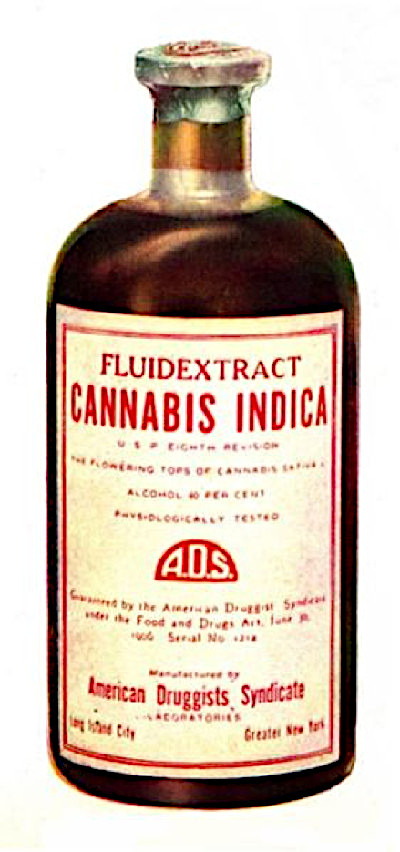
Americans began discussing what had previously been viewed as a useful crop as a harmful substance. The association of marijuana used recreationally with the influx of Mexican immigrants during the Mexican Revolution and Great Depression encouraged public sentiment against “marihuana,” as it was spelled back then. A September 28, 1935, article in The Saturday Evening Post raised concerns about marijuana’s dangerous influence in the wake of Prohibition repeal:
There are many states in which the police have no authority whatever to arrest either an addict or a peddler; that must be done by the comparatively small force of Federal men. There are likewise states which have no protection whatever against the rapidly growing sale and use of cannabis sativa, commonly known as marijuana, or hashish, and which grows as a weed in every part of America, particularly in the West.
Pretty Boy Floyd was alleged to have been crazed on marijuana when he aided in what now is known as the Kansas City Massacre. Give a Mexican smuggler enough of it and he will wade the Rio Grande, shooting as he comes, and caring nothing for the fact that he may be outnumbered four to one by border patrolmen. The gangster killer of today rarely takes a shot of cocaine to strengthen his nerves, but smokes a few marijuana cigarettes instead; they have greater effect.
By 1945 this magazine described marijuana as a “menace to the public welfare” in “Sleeping Pills Aren’t Candy” on February 24.
In April of 1937, congressmen Harry Anslinger proposed The Marihuana Tax Act of 1937. This act would require marijuana users, growers, distributors, or anyone planning “to acquire or otherwise obtain any marihuana,” to purchase a tax stamp. The drug had been a staple in medicines at the time and had not been limited by any federal regulations before 1937 (although 29 states had outlawed its use by 1931). The original act states that “Any person subject to the tax imposed by this section shall, upon payment of such tax, register his name or style and his place or places of business with the collector of the district in which such place or places of business are located.” Essentially anyone wishing to purchase a marihuana tax stamp would have to submit all of their personal information for government records.
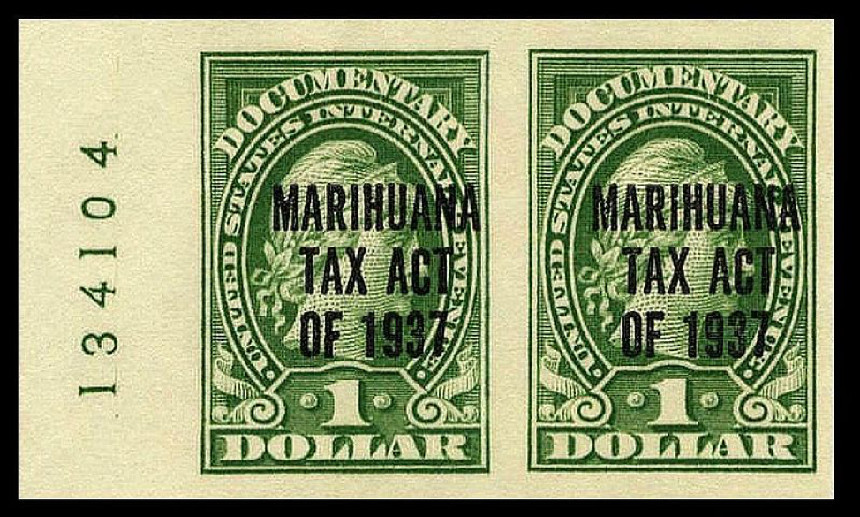
The law taxed marijuana at around $1 per ounce, or $17.95 today. The price, in addition to the forced self-reporting of anyone with a connection to the drug, discouraged its sale and use. The law was enacted on August 2, 1937, marking the day when unstamped cannabis became illegal in the United States.
The Tax Act led to the arrest of two men on its very first day, resulting in the first imprisonments due to possession and sale of marijuana. The law dictated that guilty individuals “shall be fined not more than $2,000 or imprisoned not more than five years, or both.” Samuel Caldwell was fined $1,000 and given four years’ hard labor for dealing. His client, Moses Baca, was sentenced to 18 months in prison.
The Marihuana Tax Act of 1937 were ruled unconstitutional in 1969 after the Supreme Court found it in violation of citizens’ Fifth Amendment rights. Requiring all marijuana users to identify themselves, the amount of weed they had, and where they got it from amounted to self-incrimination. The Comprehensive Drug Abuse Prevention and Control Act of 1970 (under which the Controlled Substances Act was passed) was put into action soon afterward, ensuring marijuana remained illegal and ushering in the beginning of the war on drugs.
The modern debate on the evils of marijuana seems to have turned. Today, 29 states have legalized medical marijuana and 11 have legalized weed for recreational use. Each of those states has their own laws and regulations surrounding the drug, including modern taxes.
Modern marijuana taxes to not act as a registry for all drug users but do create profit for states’ governments. The taxes obtained from weed in states that have legalized recreational marijuana rival those states’ taxes on alcohol sales. In Colorado in 2018, where recreational marijuana is legal, an ounce of weed costs $199.89. This price does not include the 2.9 percent sales tax, 10 percent special marijuana tax, or the 1 percent local tax that would add $27.79 to the price (not too far from 1937’s $17.95). Colorado generated $266,529,637 in revenue from marijuana taxes in 2018 alone.
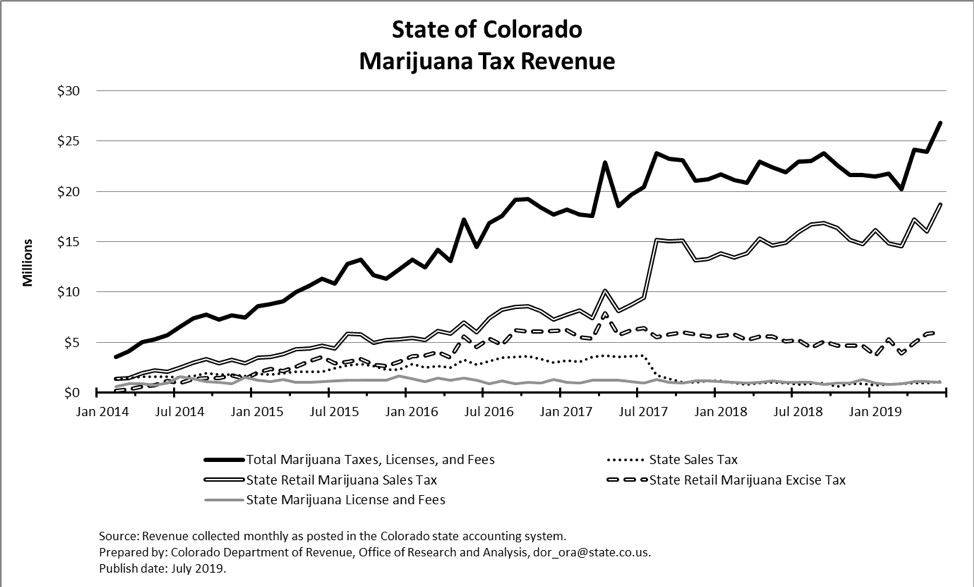
The Tax Act of 1935 did not explicitly make weed illegal, but it did give cause to arrest anyone without proper registration. This act began a spiral of legislation that did criminalize the drug (in addition to many others) and resulted in many people’s imprisonment. Taxes on marijuana today are not intended for incrimination, as individual users do not have to self-identify, and the stigma surrounding the drug has lessened in the 82 years since the tax act was passed. While federal legislation still condemns the drug as illegal, today marijuana can be purchased legally in many states — no stamp required.
Featured image: The 1937 marihuana review tax stamp (Wikimedia Commons, Department Internal Revenue; Smithsonian National Postal Museum)
5 Laws You May Be Breaking Everyday
Most Americans would consider themselves honest, law abiding citizens. But is that true? Yes, you try your hardest to follow the laws, as best you know them, but just how many laws are there? In 1982 the Department of Justice tried to count all of the criminal offenses on the books and gave up after finding 3,000.
With an incalculable amount of laws, how do you know you aren’t breaking any? Here are five laws that you may be breaking every day.
1. Violating Federal Copyright Law
To you, it may be something as harmless as copying a song from your friend’s CD to your computer, or downloading the latest blockbuster movie about a guy who can talk to fish from a not-so-official website, but to the federal government, violating copyright law is a very serious offense.
The number of items you copy and their value does have an effect on what kind of punishment you can expect. According to the Department of Justice, “The unauthorized reproduction or distribution of at least 10 copies or phonorecords, or 1 or more copyrighted works, with a retail value of more than $2,500 can be imprisoned for up to 5 years and fined up to $250,000, or both.”
But don’t think that you can get away with making an illegal copy of a CD or movie for yourself and just a few friends. The copyright holder can still file a civil suit against you, which could lead to big penalties in damages, lawyers’ fees, and court costs. In 2006, Minnesota woman Jammie Thomas-Rasset was sued by Capitol Records for uploading 24 copyrighted songs to the file-sharing site Kazaa. In 2013 she was ordered to pay $222,000 to the RIAA. The case went all the way to the Supreme Court, who declined to hear the case.
2. Gambling in Your Home

Many people across America invite friends and family into their homes each week for a game night. And while some households play Settlers of Catan or Ticket to Ride, many groups gather to play games that are considered to be illegal by many state governments.
If you host or participate in a game of chance that involves money, you could be in big trouble. Even if your state allows gambling (Nevada, New Jersey) that gambling is only allowed in government-sanctioned places, like casinos and riverboats. So inviting your friends to buy into your kitchen table $5 poker game is not allowed, and depending on the state you live in, law enforcement can arrest you.
In 2004 Guy Garner from Jackson, Tennessee was playing poker with some friends in a cabin near a state park when their game was raided by police. The pot for the game was a grand total of $20. A county judge found Garner and his friends guilty of breaking Tennessee’s gambling laws and they were ordered to pay a fine of $50.
3. Using Your Cell Phone While Driving
Today, it’s common knowledge that texting or talking on your cell phone without using a hands-free device can be pretty dangerous. Nevertheless, many of us can’t resist sending that “On my way” text or checking for the latest article from The Saturday Evening Post on Facebook. What you may not know is that even looking at your phone while driving can bring some heavy fines.
California has some of the strictest cell phone laws in the country. They ban any use of a handheld device while driving. Fines for violating these laws range from $20 to $50, but they can also come with hundreds of dollars in court and administrative costs.
Illinois recently passed a law that punishes those who text while driving. Under the new law, texting while driving will earn you a fine as well as a moving violation that could lead to a suspended license.
Currently, 15 states completely ban handheld devices while driving, while 32 additional states make it illegal to text and drive. The National Conference of State Legislatures offers a chart of the laws in each state.
4. Smoking Weed
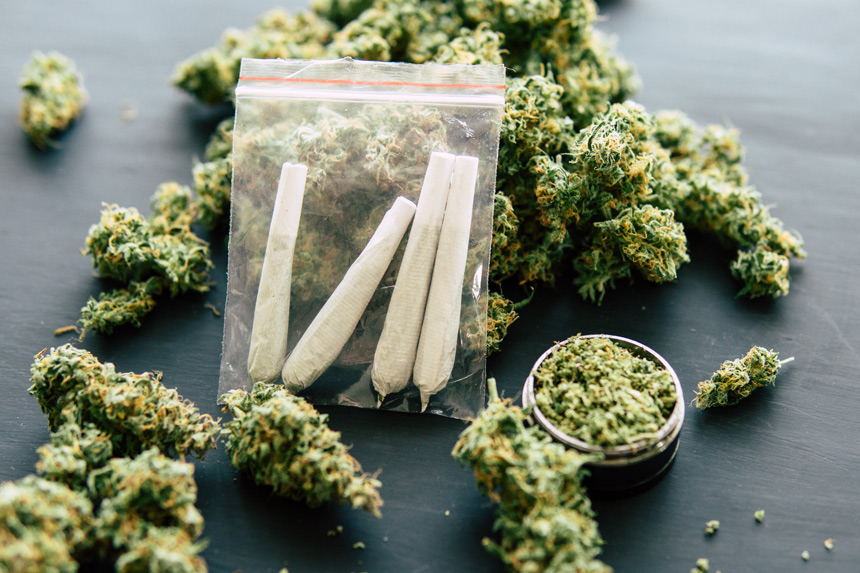
In many states across the country buying and smoking marijuana is considered legal; at least it’s considered legal by those specific state governments. States like Michigan, Colorado, and California have recently passed laws that allow the recreational use of pot, but many states across America have yet to take this step.
Even still, buying, selling, and smoking weed is still illegal on a federal level. How can you be punished by the federal government by doing something your state government considers legal?
A clause in the U.S. Constitution known as the supremacy clause essentially renders null and void a state constitutional or statutory provision or law that is inconsistent with a treaty or law that is executed by the Federal Government. In short, even if your state says its okay for you to buy and smoke weed, as long as the federal government says it’s illegal, you can still be arrested and punished for it.
Most weed smoking citizens in these states have nothing to fear. The majority of federal enforcement ends up going after the distributors and marijuana dispensaries.
5. Jaywalking
If you dart across the street without being at a designated crosswalk, you just committed a crime. Almost every major city in the United States has a law on the books that prohibits jaywalking.
Many cities disagree on what exactly it means to jaywalk, and some cities are stricter than others when it comes to enforcing these laws. Fines and penalties vary, but if your jaywalking results in an accident, or worse, you could be in a world of legal trouble.
In 2011 Raquel Nelson was convicted of reckless conduct, improperly crossing a roadway, and second-degree murder. Nelson was jaywalking across the street with her three children when an impaired driver struck and killed her 4-year-old son. The driver, who was had been drinking and taking pain killers, was sentenced to five years in prison. Two years later Nelson was cleared of the homicide charge and pleaded guilty to jaywalking.
What the 21st Amendment Can Teach Us about Legalizing Marijuana
After 48 years of being listed as a Schedule 1 controlled substance alongside drugs like heroin and LSD, marijuana may be shedding its sinister reputation. Ten states have decriminalized it for recreational use, and 23 additional states allow it for medical purposes.
Despite the growing legalization trend at the state level, Washington, D.C. has several big objections to legalizing marijuana at the federal level, including health and addiction concerns.
So what would it take for the government to overcome these objections and lift the national prohibition on marijuana? As a clue for what might happen in the future, consider how alcohol came to be decriminalized in the 1930s.
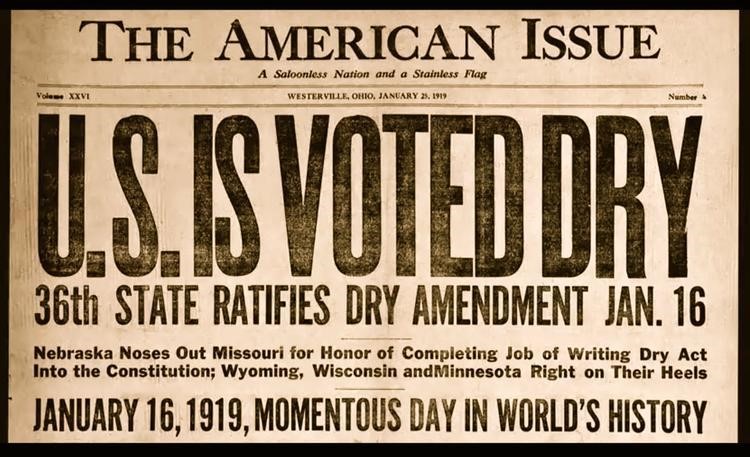
Prohibition advocates had high expectations when the 18th Amendment was ratified in January 1919. The Anti-Saloon League led the drive for prohibition, believing that a dry America would be more honest, prosperous, and harder working. They saw alcohol as a menace that had destroyed families and kept some urban Americans in perennial poverty. Saloons were widely regarded as incubators for trade union organizers and communists, a gathering spot for unwanted immigrants, and the place where crooked politicians bought and sold votes.
In addition to the moral problems brought about by alcohol and saloons, Prohibitionists saw economic upsides to a dry country. One economist predicted it would make the U.S. more productive, raising national output by 10 to 20 percent. Restaurant and theater owners hoped that prohibition would increase public demand for dining out and entertainment, and the government supported prohibition to conserve grain for the troops fighting in World War I.
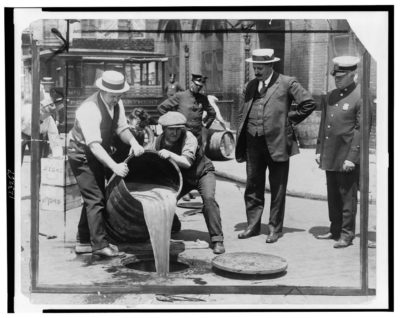
But by 1932, prohibition had lost much of its popular appeal. The saloons might have been closed, but they’d been replaced by speakeasies. New York alone had an estimated 60,000 of them. And bootleg liquor was now available at affordable prices.
Instead of making America more moral and law-abiding, Prohibition had created opportunities for organized crime to thrive and led to widespread corruption among law enforcement agencies.
Enforcement of the 18th Amendment, spelled out in the Volstead Act, had never been properly funded. The federal government depended heavily on state governments for enforcement, and states didn’t have the resources to pursue all the people involved in making and selling booze. Even non-drinking Americans were losing respect for law enforcement agencies that could not enforce the Volstead Act.
Restaurant and theater owners found that sober Americans were less interested in night life. Many restaurants failed, realizing too late that their liquor sales were the key to their profitability.
Finally, the war had ended in 1918, as had the need to conserve grains for the war effort.
The tide had turned against the 18th Amendment, but it might have remained on the books, even if widely disregarded. What brought about its repeal was the Great Depression. With unemployment hovering around 25%, Americans believed that starting up the distilleries and breweries would help create jobs.
And there was the tax revenue. Roosevelt’s many New Deal programs required lots of money. When prohibition ended alcohol excise taxes, individual income taxes were raised to make up the loss. With repeal, the Treasury Department would keep the income tax and bring back liquor excise tax.
It took the temperance movement nearly a century to achieve nationwide prohibition in America. But when Washington saw an answer to more jobs and more taxes, it took just 11 months to repeal the law.
We see a similar pattern today with cannabis. Repeal won’t be a matter of individual liberties, but of economics. Friends of marijuana are showing how pot will bring sizable tax revenue, with the potential for a million new jobs. The allure of happy, employed voters and full coffers might be too great for many politicians. As with alcohol 85 years ago, when legislators are convinced of the cost benefits of legal pot, they may be more likely to reconsider its place in American society.
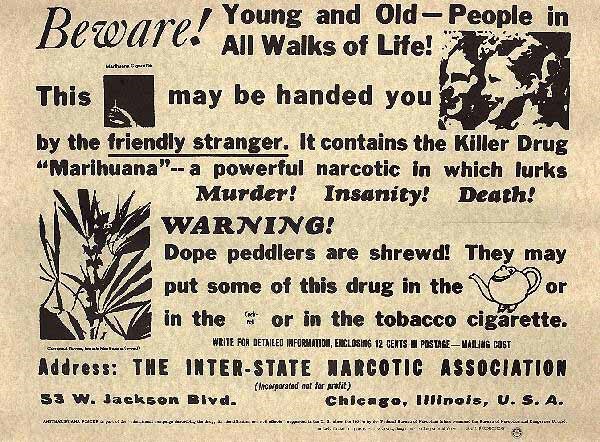
Featured image: Protest against Toronto’s prohibition laws, 1900
Your Weekly Checkup: The Possible Risks and Benefits of Marijuana
“Your Weekly Checkup” is our online column by Dr. Douglas Zipes, an internationally acclaimed cardiologist, professor, author, inventor, and authority on pacing and electrophysiology. Dr. Zipes is also a contributor to The Saturday Evening Post print magazine. Subscribe to receive thoughtful articles, new fiction, health and wellness advice, and gems from our archive.
Order Dr. Zipes’ new book, Damn the Naysayers: A Doctor’s Memoir.
Substance abuse, largely driven by an increase in marijuana smoking, has increased nationally. Marijuana is the most commonly used “illicit” drug in the United States, used by about 12% of people 12 years of age or older [PDF]. Besides smoking, an array of cannabis products exists, such as edibles, transdermal formulations, and vaping, all reducing the need for inhaling a combustible smoke product and possibly improving its safety. While marijuana is not in the addictive class of illicit drugs such as cocaine or heroin, approximately 9% of those who experiment with marijuana become drug-dependent (Drug Alcohol Depend 2011;115:120-130), a percentage even higher among those starting as teenagers. Marijuana dependency in turn can lead to an increased risk of using other illicit drugs.
The legalization of marijuana in multiple states for medical and recreational use has led to an urgent need to better understand its impact on health.
Because the brain continues developing until approximately 21 years, adolescent exposure to marijuana can be particularly harmful. Adults who smoked marijuana regularly from adolescence to adulthood have impaired neural connectivity (fewer fibers) in specific brain regions, possibly accounting for significant declines in IQ, cognitive functioning, and memory. Marijuana exposure impairs thinking, psychomotor skills, and driving ability, making it the illicit drug most frequently reported in connection with impaired driving and car accidents, including fatalities.
Long-term marijuana smoking can inflame bronchial airways, leading to bronchitis, but its risks of causing lung cancer are unclear. While it is well established that cocaine can cause heart attacks, the adverse cardiovascular effects of marijuana are less certain, though marijuana use has been linked to strokes, heart attacks, heart rhythm problems, inflammation of the heart and blood vessels, and heart muscle damage. In general, however, evidence examining the effect of marijuana on cardiovascular risk factors and outcomes, including strokes and heart attacks, is meager. In a recent study of more than 2,000 patients 50 years old or younger admitted to a hospital with a heart attack, 10% admitted to using cocaine and/or marijuana and had higher all-cause and cardiovascular mortality. Marijuana users were more likely to be smokers, which may have played a role. The incidence of out-of-hospital cardiac arrest was higher in individuals using marijuana.
We need to improve our understanding of how to capture the potential medical benefits of marijuana use while avoiding its risks. Marijuana consumption has been reported to increase appetite in wasting diseases such as AIDS, combat nausea and vomiting from cancer-treating drugs, and be beneficial in treating some symptoms of glaucoma, multiple sclerosis, Parkinson’s disease, epilepsy, chronic pain syndromes, and a host of other illnesses. Acceptable medical documentation is skimpy for most of these, however. A just-published paper suggests that marijuana liberalization might help reduce the use and consequences of prescription opioids. This would be a major advance in health care.
It’s important to recognize the possible benefits of marijuana and, at this stage, continue to gather data about this drug before deciding its permanent place in society.